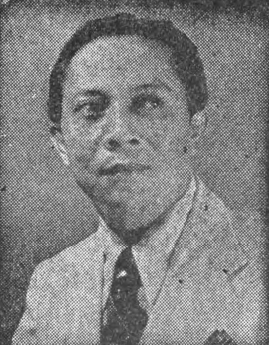Prime Minister of Indonesia facts for kids
Quick facts for kids Prime Minister of the Republic of Indonesia |
|
|---|---|

|
|
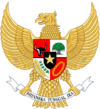
National emblem of Indonesia
|
|
| Style | His Excellency |
| Member of | Cabinet Central Indonesian National Committee People's Representative Council |
| Residence | Pancasila Building |
| Appointer | President |
| Constituting instrument | Constitution of Indonesia (Vice-Presidential Edict No.X) Provisional Constitution of 1950 |
| Precursor | None |
| Inaugural holder | Sutan Sjahrir |
| Formation | 14 November 1945 |
| Final holder | Djuanda Kartawidjaja (officially) Sukarno (unofficially) |
| Abolished | 9 July 1959 (Constitutional basis revoked) 25 July 1966 (Sukarno's resignation) |
| Deputy | Deputy Prime Minister |
The Prime Minister of the Republic of Indonesia (Indonesian: Perdana Menteri Republik Indonesia) was an important political job in Indonesia. This role existed from 1945 to 1966. During this time, the prime minister was in charge of the cabinet of Indonesia. The cabinet is like a team of top government officials. It worked alongside the People's Representative Council (a type of parliament) and the president.
After 1959, President Sukarno took over the prime minister's duties himself. He held both roles until he stepped down in 1966.
Contents
Indonesia's Early Years: The Revolution
After Indonesia declared its independence on 17 August 1945, Sukarno became the first president. The country's first constitution said Indonesia would have a presidential system. This means the president leads the government directly. So, there was no plan for a prime minister at first. The president's team, called the cabinet, reported straight to him.
However, things changed quickly. A special rule, called Vice-Presidential Edict No.X, was made. This rule meant the cabinet now had to answer to a temporary parliament. This parliament was called the Central Indonesian National Committee (KNIP). This change basically put the constitution on hold for a while.
The first cabinet was dismissed. Then, Sutan Sjahrir was asked to become Indonesia's first prime minister. He agreed, but only if he could choose his own cabinet members. His new cabinet started on 14 November 1945. The prime minister was responsible to the KNIP. But he still had to talk to the president before making big decisions. If the prime minister and the KNIP or president disagreed, a new prime minister could be chosen.
Sjahrir resigned in March 1946 because of political disagreements. But he was asked to form the next cabinet. This cabinet also fell in October. Still, Sjahrir agreed to continue as prime minister. He finally resigned for good in June 1947. This happened after he made some difficult agreements with the Dutch. Amir Sjarifuddin took his place. Sjahrir then became Indonesia's representative at the United Nations. Sjarifuddin also resigned later. This was because he lost political support after the Renville Agreement. President Sukarno then asked his vice-president, Mohammad Hatta, to form a new cabinet. This cabinet would report directly to Sukarno, not the KNIP.
United States of Indonesia Period
On 27 December 1949, the Netherlands officially gave control to Indonesia. Indonesia became a federal country called the United States of Indonesia (RUSI). The Republic of Indonesia was one part of this new federal state. The new constitution for the RUSI included a prime minister role. Mohammad Hatta became the only prime minister of the RUSI.
Because Hatta moved to this new role, there was no prime minister for the Republic of Indonesia. So, Susanto Tirtoprodjo became the acting prime minister for a short time. On 22 January 1950, a new prime minister, Abdul Halim, announced his cabinet. Both Hatta's and Halim's terms ended on 17 August 1950. This was when the RUSI was dissolved, and Indonesia became one united country again.
Liberal and Guided Democracy Eras
Under the new constitution for the united Indonesia, the cabinet again had to answer to the parliament. The president still appointed the prime minister. However, the governments were often unstable. This was because different political groups had to work together in "coalition cabinets." Prime ministers often faced "votes of no confidence." This meant parliament could vote them out of office. Any big policy change could be stopped by other parties. Because of this, some cabinets only lasted a few months.
On 5 July 1959, President Sukarno made a special rule called a presidential decree. He said that the country's special assembly could not agree on a new constitution. So, he brought back the original 1945 Constitution. This change removed the official role of prime minister.
However, on 9 July 1959, Sukarno took on the title of prime minister himself. He often said, "I am president and prime minister," in his speeches. After an attempt to overthrow the government in 1965, Sukarno's power weakened. In 1967, he lost the title of prime minister and then the presidency.
List of Prime Ministers
- Political parties
Independent Socialist Party Masyumi Party Indonesian National Party
| No. | Portrait | Name (Birth–Death) |
Term of office | Political party | ||
|---|---|---|---|---|---|---|
| Took office | Left office | Time in office | ||||
| Indonesian National Revolution (1945–1949) | ||||||
| 1 | 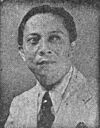 |
Sutan Sjahrir (1909–1966) |
14 November 1945 | 3 July 1947 | 1 year, 225 days | Socialist Party |
| 2 | 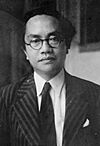 |
Amir Sjarifuddin (1907–1948) |
3 July 1947 | 29 January 1948 | 210 days | Socialist Party |
| 3 |  |
Mohammad Hatta (1902–1980) |
29 January 1948 | 20 December 1949 | 1 year, 325 days | Independent |
| United States of Indonesia (1949–1950) | ||||||
| 3 |  |
Mohammad Hatta (1902–1980) |
20 December 1949 | 6 September 1950 | 260 days | Independent |
| Republic of Indonesia (1949–1950) | ||||||
| — | 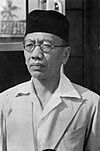 |
Susanto Tirtoprodjo (1900–1969) (Acting) |
20 December 1949 | 21 January 1950 | 32 days | Indonesian National Party |
| 4 |  |
Abdul Halim (1911–1988) |
21 January 1950 | 6 September 1950 | 228 days | Independent |
| Unitary Republic (from 1950) | ||||||
| 5 | 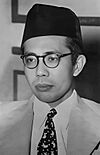 |
Mohammad Natsir (1908–1993) |
6 September 1950 | 27 April 1951 | 233 days | Masyumi Party |
| 6 | 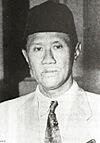 |
Soekiman Wirjosandjojo (1898–1974) |
27 April 1951 | 3 April 1952 | 342 days | Masyumi Party |
| 7 |  |
Wilopo (1908–1981) |
3 April 1952 | 30 July 1953 | 1 year, 120 days | Indonesian National Party |
| 8 | 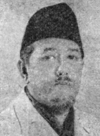 |
Ali Sastroamidjojo (1903–1976) |
30 July 1953 | 12 August 1955 | 2 years, 11 days | Indonesian National Party |
| 9 | 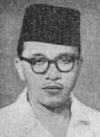 |
Burhanuddin Harahap (1917–1987) |
12 August 1955 | 24 March 1956 | 227 days | Masyumi Party |
| 10 |  |
Ali Sastroamidjojo (1903–1976) |
24 March 1956 | 9 April 1957 | 1 year, 14 days | Indonesian National Party |
| 11 | 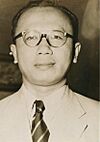 |
Djuanda Kartawidjaja (1911–1963) |
9 April 1957 | 9 July 1959 | 2 years, 91 days | Independent |
| 12 |  |
Sukarno (1901–1970) |
9 July 1959 | 25 July 1966 | 7 years, 16 days | Independent |
See also
- President of Indonesia
- Vice President of Indonesia
- Deputy Prime Minister of Indonesia
- Elections in Indonesia
- Politics of Indonesia


